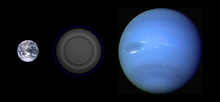Gliese 581 c
Gliese 581 c is one of at least three known exoplanets ( Gliese 581 b , c and e ) orbiting the red dwarf Gliese 581 . It is possibly in the habitable zone of its planetary system , i.e. in the area where water can exist permanently and in sufficient quantities in the liquid state due to the prevailing temperatures. The exoplanet is located in the constellation Libra , about 20.4 light years (about 193 trillion kilometers) from Earth .
properties
He needs around 13 earth days for one orbit around the central star, from which only 1/14 of the earth-sun distance separates him. The measurements made by the explorers at the University of Geneva provide a minimum mass for Gliese 581 c, which corresponds to about five times that of the earth.
With a model temperature of –3 to +40 ° C, Gliese 581 c is the first discovered planet on which temperatures like those on earth could prevail. The mentioned temperature values are estimates in which the reflection properties ( albedo , a dark object heats up more strongly in sunlight than a light one) of Venus and Earth were assumed. This equilibrium temperature does not take into account any bound rotation , in which case the hemispheres temperatures would deviate significantly from this value. In the case of an atmosphere, the actual surface temperature would also be increased by a natural greenhouse effect , which depends on the spectral radiation distribution of the central star and the composition of the atmosphere. Newer orbit and climate calculations by German scientists suggest that the planet is too hot to accommodate earth-like life forms .
The rotation of the planet is possibly linked to its orbit around its central star : One side would therefore always be facing the central star, the other always facing away. As a result, the planet would be exposed to extreme climatic conditions that split it into a cold night side and an uninhabitable day side. Atmospheric currents could enable life on the cold side, but it would be more likely that this side facing away from the stars is covered with ice.
The age of the planet, like that of the entire Gliese 581 system , is estimated to be 4.3 billion years; for comparison: The earth was formed around 4.57 billion years ago.
Orbit
Gliese 581 c orbits its star within 13 days at a distance of 11 million km (for comparison data from the earth's orbit: 365 days, 150 million km).
In fact, only the orbital period of 13 days was observed; the distance was calculated from this and from the assumed mass of the star. Strictly speaking, the 11 million km is the major semi-axis of the railway; in the case of a more elliptical orbit, the orbit would run partly closer, partly further (compare Kepler's laws ).
Because of the short distance, the star in the planet's sky would appear about five times the size of the sun or moon in the earth's sky.
discovery
The planet was discovered by a team led by Stéphane Udrys from the Geneva Observatory using a telescope at the La Silla Observatory in Chile . The same team had already discovered Gliese 581 b . The discovery was published on April 24, 2007.
Gliese 581 c was discovered using the radial velocity method (see also figure). Based on the knowledge available so far, one can only speculate about the actual nature of the exoplanet, as there are a large number of unknown factors that are reflected in current calculations.
Liquid water
Gliese is assumed to be in the habitable zone , where liquid water, the basic requirement for life according to human understanding, could exist. However, no direct evidence for this thesis has yet been produced. However, one wants to use the methods with which one could also detect water vapor in HD 209458 b to investigate Gliese 581 c . But even if water vapor is detected, the existence of life is hardly to be expected, since the central star Gliese 581 is a variable red dwarf star that shows bursts of X-rays at irregular intervals, which often exceed the lethal dose ( BY-Draconis variable ).
See also
Individual evidence
- ^ GJ 581c Extra-solar Planets Catalog
- ↑ Udry, et al. The HARPS search for southern extra-solar planets. XI, An habitable super-Earth (5M) in a 3-planet system. (PDF; 558 kB) in: Astronomy and Astrophysics (preprint).
- ↑ https://www.scientificamerican.com/article/red-star-rising/
- ^ Scientific American : All Wet? Astronomers Claim Discovery of Earth-like Planet dated April 24, 2007
- ↑ http://www.nytimes.com/2007/04/25/science/space/25planetcnd.html?_r=1&oref=slogin
Web links
- Recent research results regarding the prevailing temperatures
- Major Discovery: New Planet Could Harbor Water and Life (English)
- BBC - New 'super-Earth' found in space (English)
- Wissenschaft.de - A new cousin for the earth
- Sunrise from the Surface of Gliese 581c - Astronomy Picture of the Day from May 2, 2007 (English).
- Spiegel.de - Far high pressure world is considered a new second earth



